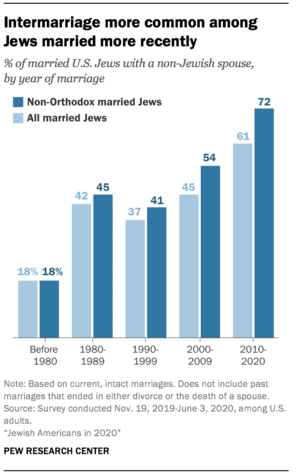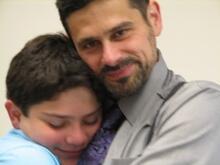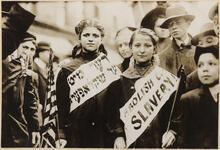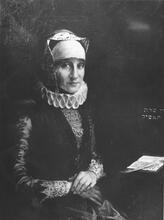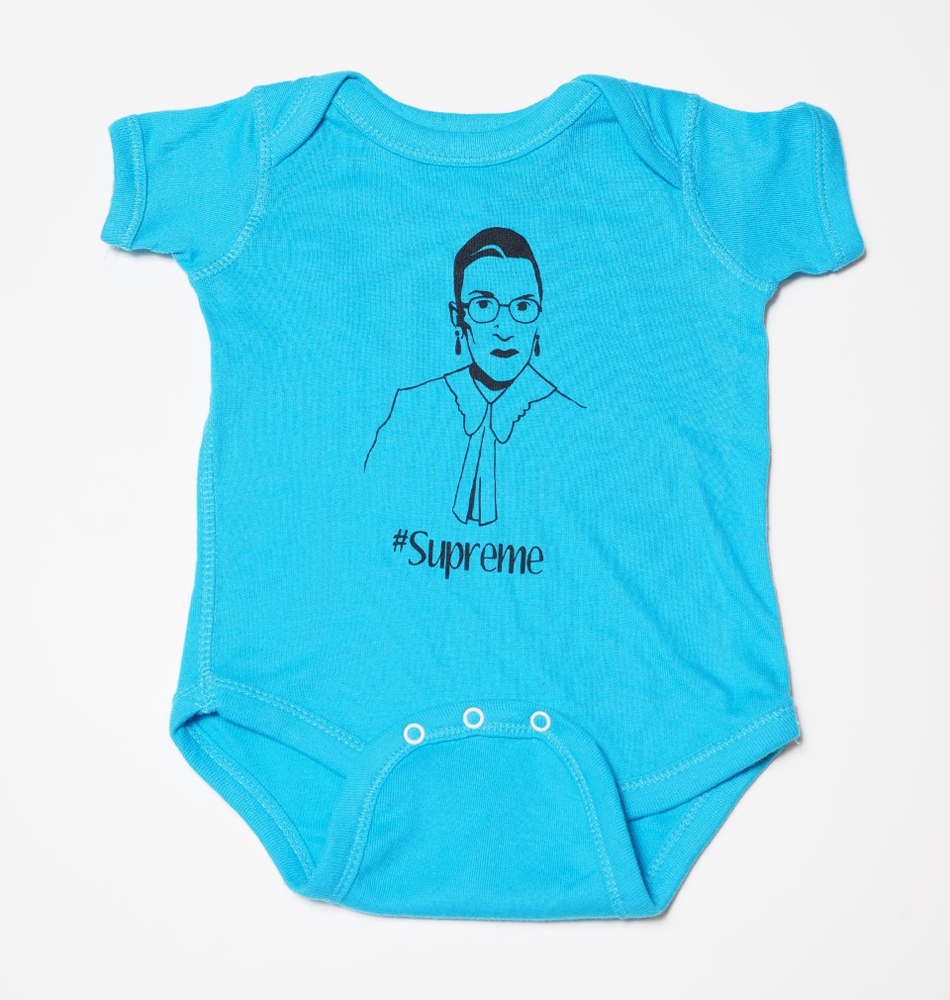Jewish Women and Intermarriage in the United States
Marriages between Jews and people of other faiths have long fascinated scholars, clergy, and communal leaders, who often considered the choice of a Jewish spouse as an indication of the strength of ethnoreligious identity and commitment to perpetuating Judaism and the Jewish people. As rates of intermarriage increased, concerns rose sharply about whether Jews—about 2.5% of the United States’ population—would literally marry out of existence. However, the very idea that marrying outside one’s religious group leads to that group’s extinction is rooted in an assumption that intermarried Jews cease to identify Jewishly, engage in the Jewish community, or raise Jewish children. In fact, many women who intermarry in the United States remain Jewish. What little research exists about Jewish women in same-sex interfaith marriage confirms that LGBTQ Jews are overrepresented among intermarried Jews.
Intermarriage in Jewish History
From Biblical times to the present day, Jews have intermarried. In the Torah it is written, “You shall not intermarry with them: do not give your daughters to their sons or take their daughters for your sons. For they will turn your children away from me to worship other gods, and the Lord’s anger will blaze forth against you and the Lord will promptly wipe you out” (Deuteronomy 7:3-4). While divine concern focused on religious loyalty, human concerns focused on familial and communal group fealty. According to The legal corpus of Jewish laws and observances as prescribed in the Torah and interpreted by rabbinic authorities, beginning with those of the Mishnah and Talmud.halakhah, marriage may only be between two Jews. But despite this condemnation, Jewish intermarriage was never as contentious in the ancient period as it became in the contemporary period.
Traditional Judaism adheres to matrilineal descent, such that only the biological offspring of intermarried Jewish women—and not the offspring of intermarried Jewish men—were considered to have halakhic Jewish status. During the last third of the twentieth century, the Reconstructionist and Reform Movements changed their policies to make descent egalitarian, and the new Secular Humanist and Renewal denominations that emerged in the 1960s and 1970s conferred Jewish status according to identification regardless of whether one or both parents were Jewish. With Conservative and Orthodox Judaism only accepting matrilineal descent (as of 2022), the lack of consensus across streams of Judaism contributes to ongoing disagreement over who is a Jew and the conflation of Jewish legal status with identity.
In what became the United States, the first intermarriage between a Jewish man and a Christian woman occurred just two years after Jews landed on the shore of New Amsterdam in 1654. In colonial days and early America, members of small Jewish communities struggled to find prospective Jewish partners, and those who belonged to elite families sometimes found marriage mates among their Gentile neighbors. In the seventeenth and eighteenth centuries and much of the nineteenth century, before large waves of Jewish immigration from Western and Eastern Europe, Jews sometimes married their own cousins—a practice widely accepted in the Jewish world prior to the development of genetic counseling—in order to avoid intermarriage. While large-scale Jewish immigration beginning in the late nineteenth century brought more prospective Jewish marriage partners, religious pluralism in the United States contributed to Jews’ ability to choose how to be Jewish…and with whom. As the Jewish population in the United States expanded, so too did Jews’ upward social mobility, increasing the potential for them to meet, fall in love with, and marry Gentile Americans.
Intermarriage in the first decades of the twentieth century was largely taboo in the American Jewish community, due to pressure from religious authorities, sensationalized media reports about Jews who intermarried, and parental pressure to stay within the Jewish fold. Prior to 1930, when only 2-3.2% of Jewish men and women married Gentiles, rabbinical organizations opposed intermarriage and the Jewish press warned Jews not to intermarry.
By 1960, the intermarriage rate had doubled, and what had earlier been considered an aberration began to be seen as a threat to Jewish continuity. Despite an evolving trend toward greater national tolerance of intermarriage, religious endogamy remained a cultural imperative to Jewish parents, most of whom reactive negatively to their children’s intermarriages. Jews who intermarried were labeled “bad Jews,” stigmatized, marginalized, and often alienated from the very community that feared their disengagement. By 1975, however, strong parental disapproval had declined, the result of Jewish political liberalism. The unprecedented rate of intermarriage, which had increased to 32% by 1972 and 52% by 1990, provoked Jewish communal activists to sound the alarm about American Judaism’s potential demise. Given how few descendants of the earliest known intermarriages had offspring who were raised Jewish and identified as such, the concern seemed warranted to many.
What sociologists, clergy, commentators, and family members did not realize was that evolving gender roles and change over time would influence the meaning of intermarriage in the long run, making it an opportunity rather than a threat. Jewish women’s intermarriage experiences were nuanced, and therefore the gendered meaning of intermarriage was more complex than quantitative studies focused on rates of intermarriage suggested. To understand the significance of intermarriage today, one needs to look at how it evolved over an entire century, specifically the twentieth century, during which American women’s lives and the status of Jews and of Judaism were affected by two world wars and several social movements. Jewish women’s intermarriages were not part of a linear continuum toward absolute assimilation. Indeed, quite the opposite was often true.
Jewish Women and Intermarriage
America’s religious freedom, ethnic diversity, and marital opportunities offered Jewish women the chance to choose their own spouses and how they would self-identify. Jewish women could marry Gentile men while also determining how they would simultaneously integrate into the American population and retain their ethno-religious heritage. The meaning of religious identity thereby became increasingly personal and individualistic, as it did for many moderately affiliated American Jews. The intrinsic struggle between the selection of a Gentile husband and the maintenance of a Jewish identity evolved considerably over the twentieth century, as American women gained more political rights and personal power within their marriages. The democratic culture made it possible to blend into the mainstream, as some Jewish women did when they intermarried, but it also increasingly encouraged them to assert their Jewishness. How family and community members responded to Jewish women who intermarried influenced whether, and to what extent, they remained engaged or drifted away.
The experience and meaning of intermarriage for Jewish women in America changed dramatically over the twentieth century. Prior to the First World War, when the rate of Jewish intermarriage was at its lowest, the immigrant Jewish women Mary Antin, Rose Pastor (Stokes), and Anna Strunsky (Walling) intermarried and moved out of the Jewish fold and into the circles of their Gentile husbands and mainstream society. Although the few immigrant Jewish women whom we know intermarried between 1900 and 1929 did not explicitly renounce their Jewish identities, each joined her husband’s larger nonsectarian sphere. These women shed much of their immigrant backgrounds as they fulfilled the American dream of romantic love through marriage. Antin and Strunsky experimented with other religions, yet none of the women completely abandoned her Jewish identity in favor of a non-Jewish affiliation, showing the ability of some women to both intermarry and remain Jewish. Although they may have largely disappeared from Jewish immigrant life, they did not disappear as Jews. Moreover, that all three marriages dissolved because of political and economic disagreements between the spouses indicates that religious differences were not the cause of the women’s unhappiness, as contemporary commentators had forecast.
Many Jewish women in the 1930s, 1940s, and 1950s similarly merged into the dominant culture through intermarriage, now with the aid of diminished religiosity, assimilation, and increased educational and employment opportunities. For the women who married Gentile men in the face of rising antisemitism leading up to World War II, as well as during the postwar years, when the ghost of prejudice lingered psychologically, intermarriage provided a social escape from their ethno-religious group. Antisemitism may have deterred many Gentiles from marrying Jews, but it also motivated some Jewish women to seek refuge with “the enemy.” Women who intermarried between 1930 and 1960 were mostly second- and third-generation Americans who made a wider variety of choices concerning both identity and family religious life. Some Jewish women who intermarried during these three decades avoided overtly identifying as Jewish and raised children either in the religion of their spouse or as Unitarian. Others maintained their ties to their heritage and even identified as “more Jewish,” a significant change from the beginning of the century. Whichever path of self-identification the women chose, they continued to be labeled as “Jewish” by others, even when the women considered themselves something else. Clearly the women who seemed to run from their Jewish community by intermarrying could not hide: being Jewish was socially inescapable.
Whereas their predecessors were sometimes influenced by prejudice in deciding whom to marry and how to identify, the political liberalism, ecumenism, and feminism of the 1960s and 1970s enabled an increasing number of Jewish women to intermarry and, ironically, identify more proactively as Jews. These decades marked a critical turning point during which the Civil Rights movement encouraged people to overlook differences in religion and race, leading to greater communication between Jewish and Christian denominations and contributing to a spike in the rate of Jewish intermarriage. The second-wave feminist movement, many of whose leaders were Jewish women, also redefined marriage as an institution in which women could advocate for their equality to men and therefore their right to actively shape their family life. Illustrating the dual influences of feminism—Jewish feminism in particular—and the rise in ethnic consciousness, many women who intermarried in the 1960s and 1970s were, for the first time in history, considerably more outspoken about being Jewish and about raising Jewish children. Jewish women’s heightened awareness of the Holocaust also made many feel connected to, and more invested in, the future of the Jewish people.
Jewish women who intermarried between 1980 and 2000 were among an unprecedented majority of Jews who married Gentiles, and yet their minority status became threefold: intermarried, Jewish, and living in a society where the dominant identity was Christian male. The high degree of individualism in general American society, combined with ethnic revivalism, enabled some women of Jewish heritage to marry Gentile men and, paradoxically, to become considerably more Jewish once married. An increasing number of Jewish women retained their own names when they wed, reflecting a change in marriage customs as well as a determination to maintain a Jewish identity apart from their Gentile husbands. Having children further accentuated some women’s Jewish identities and, while bearing the brunt of domestic responsibilities, made them more proactive about Jewish observance, education, and communal connections. Despite the greater number of intermarried Jews by the end of the century, intermarried Jewish women remained marginalized, both in a predominantly Christian and male-dominated society and in organized Jewish communities, which persistently scorned intermarriage.
Intermarried Jewish women illustrate the gains some American women made toward equality with men, such as greater educational and employment opportunities, but also the tenacity of gendered behaviors regarding domesticity and religion. Intermarried Jewish women consistently had careers and more responsibility for child rearing and domestic religion than did their Gentile husbands. By voluntarily doing all the necessary planning and most of the physical labor involved in religious observance and cultural participation, those Jewish women raising Jewish children assumed responsibilities that in an allegedly post-feminist society one might hope would be equally shared between both parents. They thereby reinforced the social expectation that women are the purveyors of a Judaism increasingly practiced in the home in addition to or instead of the synagogue. In this sense, the actions of intermarried Jewish women were no different than other ethnic women who brought their children to church or did most of the Christmas shopping.
Gender Matters
Using gender as a category of analysis and with the benefit of hindsight, twenty-first-century historians of Jews have illuminated how the negative narrative about Jewish intermarriage was socially constructed. The “continuity crisis” narrative that had held Jewish communal consciousness in a vise grip kept in the shadows other scholarship that suggested that being Jewish remained a vibrant identification to some who intermarried, or that it could become such in due course; that intermarriage could add Jews, rather than subtract; and that there can be multi-ethnic, multi-racial children of intermarriage who are 100% Jewish. Eventually, the national studies found what some gender scholars already knew. A Portrait of Jewish Americans (2013) and American Jews in 2020 by the Pew Research Center found both unprecedented rates of intermarriage (72% of non-Orthodox Jews who wed between 2010 and 2020 intermarried) and increased rates of children of intermarried couples being raised Jewish. These findings underscored that one Jewish parent can successfully raise Jewish children. However, there remains a gender disparity regarding raising Jewish children: children of Jewish mothers married to Gentile men are more likely to be raised Jewish than children of Jewish fathers married to Gentile women. Jewish men can raise Jewish children equally effectively as Jewish women do, yet their gendered ethnicity undermines them as Jewish parents.
Jewish women in the United States both dismantle the old narrative about intermarriage and point to ongoing gender inequality. Beginning in the 1960s and increasingly in the following decades, intermarried Jewish women initiated a Jewish-feminist modus vivendi in which they were both the gatekeepers of, and door openers to, Jewish life for their families. Increasingly, intermarried Jewish women determined the religious beliefs that entered their homes and the cultural practices that were initiated, reconnecting with traditions that had sometimes fallen by the wayside in the homes of their parents and grandparents. Intermarried Jewish women combined ethnicity and domesticity with assertiveness and ingenuity to create Jewish identities that were personally meaningful. Reinventing and refurbishing their religious and ethnic heritage in ways that felt authentically Jewish, intermarried Jewish women sought opportunities to identify as Jews and inspire the Jewish identities of their children. If there is a silver lining in what scholars have called “the second shift,” the working mother’s role as primary caregiver and domestic overseer, it is the power of intermarried Jewish women to determine the religious orientation, activities, and communal involvement of their families. Ethno-religious domesticity, indeed all domestic labor, was under-appreciated, and yet it had intrinsic value for intermarried women who sought to identify as more Jewish, not to mention its value in perpetuating the Jewish religion, culture, and people.
Jewish gender is at work whether a couple is made up of a Jewish woman and a Gentile man or a Jewish man and a Gentile woman. Jewish women in interfaith marriages are often both the deciders and the doers, increasingly making sure that their children are raised as Jewish. Jewish men, by contrast, are often the deciders, but the bulk of domestic and childcare burdens, including Jewish education, remains on the shoulders of their Christian-born wives, some of whom identify as Jewish. What makes Jewish gender all the more significant is that Jewish fathers are caught between wanting to be “mensches” who make the world a better place and the American “rules” of masculinity that encourage them to win, to get ahead, to make more money, buy more toys and bigger houses. This Jewish masculine mystique, stemming from these competing priorities and communal disenfranchisement, inhibits Jewish men’s ability to raise Jewish children as effectively as intermarried Jewish women.
Similarities and Differences Between Sexes
The similarities and differences between intermarried Jewish women and intermarried Jewish men shed light on how religious identity and practice are influenced by the social construction of gender in the United States. Four striking similarities between intermarried Jewish men and intermarried Jewish women in the contemporary United States merit some discussion. First is the most obvious point: most men who married “out” were, like women, still Jewish. Second, the influence of becoming a parent on men’s and women’s Jewish identities was similar, often heightening their awareness of being Jewish. Some men who intermarry switch denominations from more traditional to more liberal, but this change over time often entails an enhancement, not a diminishment, of their Jewish identity. Third, both men and women were often influenced by a parent’s intermarriage, reflecting national demographic data that Jewish adults who were the children of intermarriages were three times more likely to marry non-Jews themselves. Lastly, in the cases where intermarried Jewish men and intermarried Jewish women divorced, both generally did so for reasons unrelated to religious differences, most often involving adultery, financial issues, or problems with substance abuse. While religious differences did not always drive couples apart, further study is needed to determine the powerful role that cultural differences may play in marital disunion.
Differences between intermarried Jewish men and intermarried Jewish women were also significant. The most profound difference between men and women regarded denominational shifting: intermarried Jewish women maintained the denominational affiliations in which they had been raised, whereas a majority of the men switched after they intermarried. The experiences of intermarried Jewish mothers and intermarried Jewish fathers were distinct due to traditional family structures and ongoing gender disparity in the workforce. The Holocaust factored differently into intermarried men and women’s lives. For many women, the decimation of Eastern European Jewry encouraged their raising of Jewish children but did not influence their feelings about Judaism per se. In contrast, the legacy of the Holocaust played a much more significant role in men’s consciousness with regard to their relationships with Judaism, challenging them to define what being Jewish meant to them. Since there was no male equivalent to the maternal keeper of the domestic flame of Judaism, Jewish men questioned their roles in Judaism. In addition, men had much shorter fuses when rabbis declined to officiate at their wedding or they felt ostracized by the organized Jewish community, whereas women did not take such great offense.
Towards A New Narrative
Intermarried Jewish women epitomized both the liberty America celebrated to live as one wished and the challenge of defining the meaning of being Jewish in a society where interfaith marriage, by the first years of the twenty-first century, had become as American as apple pie. Yet intermarriage is not always an adversary to Jewish continuity as once was the concern; rather, it can also be an opportunity for self-reflection and personal growth. In the words of the late sociologist Egon Mayer, intermarried women with accentuated Jewish identities “took advantage of cultural pluralism not by blending into the majority but by absorbing” Gentile members of the majority (Mayer, “Why Not Judaism?”). Sarah Coleman, an intermarried, third-wave Jewish feminist, pointed out that “in forming partnerships with non-Jews, we intermarrieds are spreading Jewish values and culture into the population at large” (Coleman,). Intermarriage and Jewish women in the United States is a story that is both uniquely Jewish and uniquely American. Their children and grandchildren will continue to reshape the meaning of being Jewish and female in America, regardless of who or whether they marry.
McGinity, Keren R. Still Jewish: A History of Women and Intermarriage in America. pp. 197-203. ©2009 [Copyright Holder]. Reprinted with permission of New York University Press.
McGinity, Keren R. Marrying Out: Jewish Men, Intermarriage, and Fatherhood. pp. 63-90. © 2014 [Copyright Holder]. Reprinted with permission of Indiana University Press.
Coleman, Sarah. “Not Lost: A Jewish Feminist Atheist Meditates on Intermarriage.” Yentl’s Revenge: The Next Wave of Jewish Feminism, ed. Danya Ruttenberg. New York: Seal, 2001.
Corwin Berman, Lila, Roseblatt, Kate, and Ronit Y. Stahl. “Continuity Crisis: The History and Sexual Politics of an American Jewish Communal Project.” American Jewish History, vol. 104, nos 2/3 (April/July 2020), pp 167-194.
Cowan, Paul and Rachel. Mixed Blessings: Overcoming the Stumbling Blocks in An Interfaith Marriage. New York: Penguin, 1988.
Feldberg, Michael. “Jewish Continuity in Early America.” https://www.jewishvirtuallibrary.org/jewish-ldquo-continuity-rdquo-in-e…
Firestone, Tirzah. With Roots in Heaven: One Woman’s Passionate Journey into the Heart of Her Faith. New York: Dutton, 1998.
Handlarski, Denise. The A-Z of Intermarriage. Toronto: New Jewish Press, 2020.
Kaplan, Jane. Interfaith Families: Personal Stories of Jewish-Christian Intermarriage (Westport, Conn.: Praeger, 2004).
Kiyong Kim, Helen and Samuel Leavitt, Noah. JewAsian: Race, Religion, and Identity for America’s Newest Jews. Lincoln: University of Nebraska Press, 2016.
Kotler-Berkowitz, Laurence et al., The National Jewish Population Survey 2000–01: Strength, Challenge and Diversity in the American Jewish Population (New York: United Jewish Communities, 2003).
Mayer, Egon. Love and Tradition: Marriage Between Jews and Christians. New York: Schocken Books, 1985.
Mayer, Egon. “Why Not Judaism?” Moment, October 1999.
McGinity, Keren R. Still Jewish: A History of Women and Intermarriage in America. New York: New York University Press, 2009; pb 2012.
McGinity. Marrying Out: Jewish Men, Intermarriage, and Fatherhood. Bloomington: Indiana University Press, 2014.
McGinity. Journal of Jewish Identities, Special Issue on Intermarriage and Authenticity, issue 8, no. 1. Youngstown, OH: Youngstown University, January 2015.
McGinity. “The Unfinished Business of the Sexual Revolution.” American Jewish History, vol. 104, nos 2/3 (April/July 2020), pp. 207-213.
Mehta, Samira K. Beyond Chrismukkah: The Christian-Jewish Interfaith Family in the United States. Chapel Hill: University of North Carolina Press, 2018.
Meyers, Helene. “A Polemical Epilogue: Intermarriage—Jewish Betrayal or Loving Coalitions” in Identity Papers (Albany: State University of New York, 2011).
Pew Research Center, A Portrait of Jewish Americans, 2013.
https://www.pewresearch.org/wp-content/uploads/sites/7/2013/10/jewish-a…
Pew Research Center, American Jews in 2020.
https://www.pewforum.org/2021/05/11/jewish-americans-in-2020/
Rebhun, Uzi. Jews and the American Religious Landscape. New York: Columbia University Press, 2016.
Reinharz, Shulamit and DellaPergola, Sergio eds. Jewish Intermarriage Around the World. New Brunswick and London: Transaction Publishers, 2009.
Sarna, Jonathan. American Judaism: A History. New Haven: Yale University Press, 2004.
Sasson, Theodore et al. “Millennial Children of Intermarriage: Touchpoints and Trajectories of Jewish Engagement.” Waltham: Cohen Center for Modern Jewish Studies at Brandeis University, October 2015. https://www.brandeis.edu/cmjs/noteworthy/officiation.html
Saxe, Leonard et al. “Under the Chuppah: Rabbinic Officiation and Intermarriage.” Waltham: Cohen Center for Modern Jewish Studies at Brandeis University, August 2016. https://www.brandeis.edu/cmjs/noteworthy/officiation.html
Spickard, Paul. Mixed Blood: Intermarriage and Ethnic Identity in Twentieth-Century America. Madison: University of Wisconsin, 1989.
Thompson, Jennifer A. Jewish on Their Own Terms: How Intermarried Couples are Changing American Judaism. New Brunswick, NJ: Rutgers University Press, 2014.


